2021 December 31
BAA Awards 2021
WALTER GOODACRE AWARD
Lyn Smith
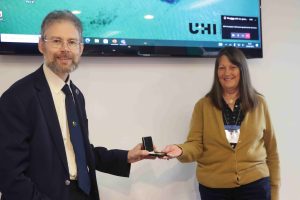
Lyn Smith is a distinguished solar observer and since June 2006 has been Director of the BAA Solar Section. Lyn has been in post 15 years, making her the longest serving Solar Section Director. The previous longest serving Director was Edward Maunder, from October 1910 to April 1925 (14.5 years).
As Director, Lyn has been instrumental in keeping the Section’s activities at the forefront of solar research through the observations they obtain. Consequently, the Section’s contributions to solar astronomy are widely recognised within the Association and far beyond. A key part of this has been her commitment to analyse and report the work of the Section in the Journal. There is a formidable list of refereed and non-refereed items in the Journal of the BAA for the majority of which Lyn is the lead or sole author. They include regular Notes & News articles she has penned for every issue since becoming Director. She also edited a BAA booklet on Solar Observing as well as creating a BAA Leaflet on the Sun for distribution at events and meetings.
In addition, Lyn is Editor of the monthly Solar Section Newsletter, which is received by about 250 people. The Newsletter comprises detailed observation summaries, analyses and news items.
Compiling the Section reports for the Journal and the Newsletter takes many hours each month. Before the Solar Section databases came along a few years ago, the collation of members’ solar white light and Ha daily measurements was done using an Excel spreadsheet. This required manual input or cut/paste of individual members spreadsheets into the master spreadsheet for about 50 members in white light (sunspot groups and R, the relative sunspot number) and 20 for Ha (prominence, filaments and flares). Now it is quicker, since members submit observations into the Section’s databases, but it is still time consuming and requires a high degree of diligence and attention to detail. On top of this, there is the collation of the description of each sunspot group for the Journal. Lyn also receives 300+ images each month, which need to be reviewed to decide which ones to include in the Journal and Newsletter.
Lyn’s analyses and reports ensure that the valuable work done by members of the Section is available to other researchers worldwide. It also maintains the stature of the Solar Section, and the Association, in the astronomical community. Lyn has links to the professional research community, primarily via the Solar influences Data analysis Center, Belgium, which is responsible for the creation of the international Sunspot Number (Ri). She has recommended several long-established observers to-be included in the ~70 observers and observatories that contribute to Ri.
Lyn regularly gives solar talks to astronomical societies as well as at various BAA meetings, including B2B meetings. She has also written solar articles for various UK astronomy magazines. Her presentations and personal encouragement have been instrumental in many new observers taking up Solar astronomy.
Lyn’s impact on the Association has been far wider than the BAA Solar Section. As a senior leader in the Association she is a role model for women observers. Moreover, her work as chair of the BAA Gender Balance Working Group led to recommendations to improve representation of female observers in the Journal, including the introduction of author photographs, which she instigated.
MERLIN MEDAL & GIFT
Raffaello Lena and Barry Fitz-gerald
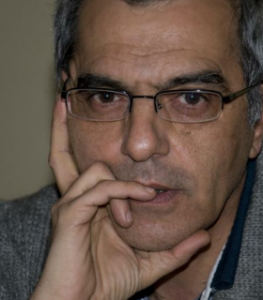
Raffaello Lena is a distinguished Italian amateur astronomer, living in Rome, and is a regular contributor to the BAA. An active member of the Lunar Section Committee, he writes a monthly column on volcanic domes for the Lunar Section Circular as well as contributing regularly to the Section’s other publication The Moon: Occasional Papers. He has also written many original research papers for the BAA Journal. Raf’s work on lunar domes has received international acclaim from both amateurs and professionals. The well-known professional lunar scientist Chuck Wood has referred to him as the ‘dome master’, writing that ‘Raffaello Lena and his colleagues have elevated amateur lunar studies to the professional level.’ Raf was the founder of the Geological Lunar Research group and was the lead editor of its journal Selenology Today.
Raf’s book, which he was the lead author, Lunar Domes: Properties and Formation Processes (Springer- Praxis, 2013), is recognised as the standard work on the subject. His work on the cataloguing, classification and morphology of lunar domes has also appeared in professional journals, including Icarus, Planetary and Space Science, and the Proceedings of the LPSC conference. In 2018 the main belt asteroid, 1999 TG12 was named ‘Raffaellolena’ in Raf’s honour.
Like Raf, Barry Fitz-Gerald has a long and distinguished history of contributions to lunar studies and to the work of the Lunar Section, of which he too is a Committee member. Active in the Section since the 1990s, Barry has long championed the cause of lunar geological studies and shown that the amateur can make a worthwhile contribution to the field, one that is recognised by professional colleagues. He too contributes regularly to Section publications and to the BAA Journal. His research papers have also appeared in professional publications, including Icarus, Planetary and Space Science, and Lunar & Planetary Science. Whereas Raf’s interests are centred (although not exclusively) on lunar domes, Barry has deployed his geological knowledge in the investigation of a variety of lunar landforms, including a reinterpretation of how concentric craters might have formed. A recent issue of the Lunar Section Circular contains a tenacious and convincing interpretation of the tortured morphology of the strange lunar crater Gaudibert.
Barry and Raf could each merit the award of the Merlin medal, however, a joint award was made to recognise their regular collaborations on joint papers, both in our Journal and in professional periodicals, where the different emphases of their skills have combined to produce outstanding results. Their work together has served to foreground a whole new raft of opportunities open to the amateur selenographer as a result of the ready availability of professional data on-line; and this has had a significant impact on how the Lunar Section now goes about its work. Both Barry and Raf are active observers — Barry has a home observatory and Raf regularly submits images to the BAA —but they have pioneered in the Section the use of spacecraft imagery and datasets to complement the results of telescopic observation. They have mastered the use and interpretation of professional datasets in order to derive highly sophisticated geological information. This has brought a new and important dimension to amateur study of the Moon.
STEAVENSON MEMORIAL AWARD
Dale Holt
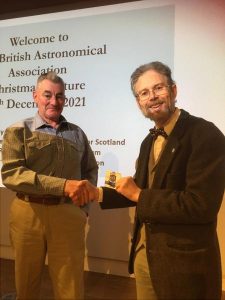
Dale Holt has been a member of the Association for around 14 years, and he is a prolific observer mostly of the Deep Sky, and has submitted around 760 observations to the Deep Sky Section between 2007 and 2021.
He observes whenever the opportunity arises and uses a unique technique, utilising a sensitive video camera at the focus of his 505mm reflector. The camera feeds to a monitor, where careful adjustments are made to enhance the view, whereupon Dale makes sketches of the object in question. Usually the sketches are black on white, but Dale also makes sketches using white medium on black art paper. The sketches are then scanned and inverted as required for circulation to interested observers and the BAA Deep Sky Section
Dale’s observing campaigns are mainly on distant galaxies, notably objects in Halton Arp’s catalogue of peculiar galaxies, and the Hickson Groups of galaxies though he often turns his scope to other objects which are under-observed. His observations regularly appear in the Deep Sky Section newsletter and frequently in the BAA Journal, and have also featured in Sky & Telescope magazine.
SIR PATRICK MOORE PRIZE
Mary McIntyre
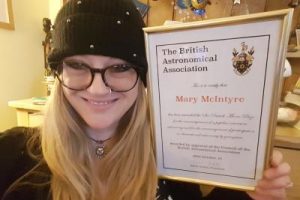
Mary, a self-confessed science “geek”, has been interested in astronomy since her early years. She studied GCSE in astronomy, and then went on study the Certificate in Astronomy and Planetary Science with the Open University. She has been a member of the BAA since 2015, a member of the SPA since 2014, a member of the Society for the History of Astronomy and a Fellow of the Royal Astronomical Society since 2018.
Mary was the first woman to do both the William Fox Memorial Lecture on two separate occasions at the Horncastle Astronomy Weekend and present the Sky Notes lecture at the BAA monthly meeting in January 2020.
Her main interest is giving talks and is presenting 50 – 60 lectures per year on a wide range of astronomy subjects. These include a history of women in astronomy; using the length of shadows to calculate the height of lunar features; the mythology of constellations; atmospheric optics; various astrophotography subjects; astronomy and space art and hands-on astronomy sketching workshops. She has recently invested in a new camera and boom arm so she can teach astronomy sketching via Zoom. Recently, her History of Women in Astronomy talk was recorded and used by a lecturer at the University of Central Lancashire for one of his undergraduate classes. She has always been involved with talks for local cub/scout groups as well as in local schools, and this has been extended, promoting astronomy to non-astronomy groups such as the WI, U3A, audio only talks to visually impaired groups and local history societies. Added to this, she accompanies all of her practical astrophotography talks with a PDF summary guide on how to photograph that particular subject and she circulates this free of charge to all attendees. On her You Tube channel she produces tutorial style videos in addition to her usual video content so she can share that knowledge to a wider audience. When sharing a time lapse video, she fills the description box with all of the information needed for people to replicate it themselves, as well as providing one to one support to people who have attended her talks and workshops.
She has been a guest on several podcasts promoting astronomy and astrophotography to a non-astronomy audience. She has been involved with several online festivals during this past year, and has been on many “Ask an Astronomer” Q&A Panels. Mary is a regular contributor on the panel of the Reach Out and Touch Space show on Astro Radio and is a regular co-host of the Astronomy FM show Comet Watch. She has appeared on BBC Radio Oxford, BBC Radio Four and BBC Five Live talking about astronomy events. At a local level she runs informal outreach events in her back garden whenever there is an interesting astronomy event so that people of her village can learn about the universe and the joys of the night sky.
Mary’s outreach is truly international. Recently she gave an overseas talk that was translated live into Farsi, and will shortly be giving a talk to a society in New Zealand. The pandemic has helped her reach a world-wide audience now that lectures over the internet are the norm. Mary does have mobility issues and so talks via platforms such as Zoom has greatly increased her ability to regularly reach a wider audience.
Mary operates four meteor cameras that are part of the UK Meteor Network. She helps to look after the network’s You Tube channel, creating video compilations of interesting meteor captures. These are used for outreach and to promote and to encourage observation of meteor showers and she contributed data that helped to find the Winchcombe Meteorite.
In addition, Mary is a freelance astronomy writer who is a regular contributor to Sky at Night magazine and during lockdown she has written several articles that involve astronomy related craft projects for all the family to enjoy. She has written for the Yearbook of Astronomy with a series of articles about important female astronomers throughout history as well as writing articles for online magazines and her own blog page, targeting beginners.
Mary also oversees the UK Women in Astronomy Network social media channels where she shares information about inspiring female astronomers throughout history to provide role models for younger girls who may be thinking about a career in astronomy, as well as running the UK Women in Astronomy Network Flickr group where female astro- photographers can share their work and provide inspiration for others. She recently contributed some important observations on Nova Cas 2021 and has appeared as a guest on the SPA Live chat show.
Mary has contributed to the BAA Aurora Section, photographing faint aurora from Oxfordshire, not always visible to the casual observer. Her photography is simply amazing and her reporting excellent.
In summing up, Mary is an outstanding ambassador for astronomy and is willing to go that extra mile to help and encourage others. Her commitment to astronomy and her advancement of the subject world-wide, makes her an ideal candidate for this prestigious award.
Howard Parkin
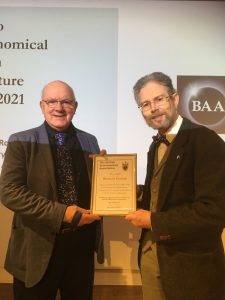
Howard has a true passion for inspiring people to become interested in astronomy.
He started adult education classes in astronomy in 1985, which he still continues to teach.
In 1989 he became a founder member of the Isle of Man Astronomical Society, serving 15 years as Chairman, and is currently Vice Chairman and Press Officer. During all this time Howard has delivered numerous lectures to the society members, visiting groups and even the Chief Minister and politicians from the Isle of Man Government. This was a marvellous opportunity to promote Dark Skies in the Isle of Man.
Howard hosts many events around the Island including astronomy themed steam train trips, Manx Electric Railway trips to the top of the highest point on the Isle of Man, Snaefell, and numerous other outreach events at Manx National Heritage sites. These events usually end up, where clear, with Howard pointing out the constellations, planets, and any other points of interest visible at the time. An event with Manx National Heritage, involved hosting a live link with the international Space Station to talk with Astronaut Nicole Stott.
He regularly visits local schools to talk about astronomy and has hosted numerous groups of Scouts and Brownies at the Isle of Man Observatory, in order to help them obtain their astronomy badges. In one instance he helped a local school to win an International Astronomical Union competition to name an Extra-Solar planet.
He has set up his own astronomy consultancy firm, AstroManx, through which he was instrumental in obtaining dark sky status for 26 sites on the Isle of Man.
Howard has also advised the Isle of Man Postal Authority in producing astronomy based stamps.
He has been guest lecturer and resident astronomer on many cruise ships around the world, providing lectures on astronomy, including the Aurora Borealis and space themed subjects. He appears on a regular monthly half hour programme, on Manx Radio, providing information about the night sky and current up to date news about astronomy and space . He is the ‘go to’ person for the radio station, who refer to him as Mr Astronomy.
With the problems following the Covid pandemic He has been delivering Zoom talks to the Isle of Man Society, other societies and groups on the Island and across the Uk .
Howard has an enthusiasm for astronomy that crosses all age groups and abilities. He has certainly encouraged people to get interested and involved in the subject, bringing many new members in to the Isle of Man Astronomical Society. Howard is passionate in passing on his knowledge and love of astronomy at every opportunity available.
Andrew Robertson
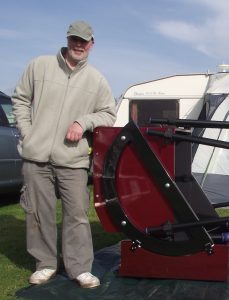
Andrew Robertson has a lifetime of observing, support for others, and a continuing contribution to astronomy.
Andrew has served as Chair of Loughton AS, been a committee member of the international Webb Deep-Sky Society and served on the committees of several other local societies. He has enthusiastically organised, as well as led, countless outreach sessions within the local societies with which he has been associated as well as at Star Parties.
His contribution to the founding and continuation of major Star Parties currently at Kelling Heath and more recently at Haw Wood has been pivotal. From its origins at Thetford, Andrew led in moving to the larger venue of Kelling Heath and it has now become one of the largest Star Parties in the world, in the service of all and attracting very experienced amateurs.
Andrew has similarly overseen the growth of the Haw Wood Star Party on behalf of Breckland AS which now encompasses at least four other societies.
An active speaker, Andrew regularly gives talks ranging from popular to highly technical, and at venues from Cambridge University to numerous local astronomical societies, for example Webb Deep-Sky meetings, the BAA Deep Sky Section and telescope building for specialist engineers.
This has been accomplished within Andrew’s overwhelming passion for visual observing. During a lifetime of practical first-hand observing, particularly deep sky, he has built an almost un-paralleled visual knowledge of the northern hemisphere through observing a huge number of objects using a wide range of instruments under a wide range of conditions. This has led to recognition of his expertise by many highly experienced global experts with whom he is on close terms and from whom he receives regular observing invitations.
Andrew has a lifelong and overwhelming enthusiasm and knowledge of amateur astronomy and an enduring desire to communicate it to everyone who wants to hear.
https://britastro.org/wp-content/uploads/2022/12/0A617C13-5E6E-421B-B142-42ED5E178B6F-scaled.jpeg
| The British Astronomical Association supports amateur astronomers around the UK and the rest of the world. Find out more about the BAA or join us. |
